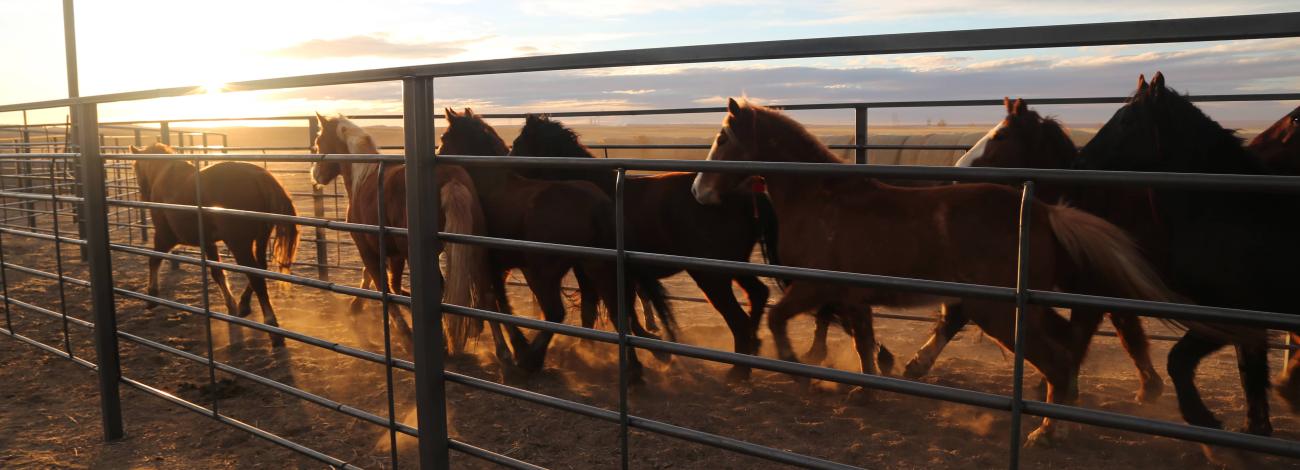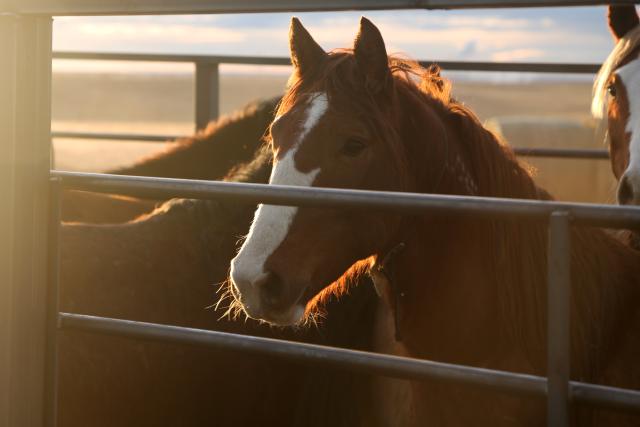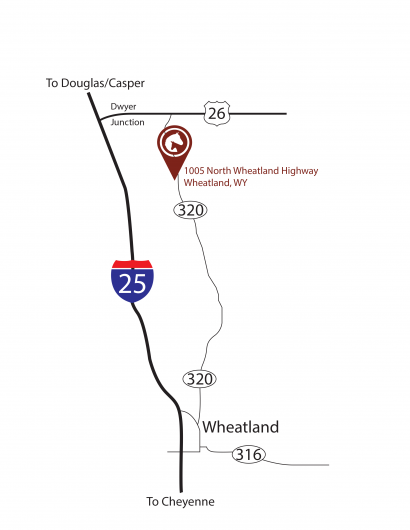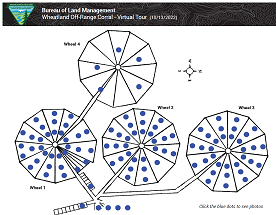
Wheatland Off-Range Corral
The Wheatland Off-Range Corral is a privately owned, BLM contracted, more than 200-acre facility dedicated to the housing of up to 3,500 wild horses and burros. It serves as a preparation center for wild horses and burros gathered from overpopulated herd management areas. Additionally, the facility can also serve as a rest stop location for wild horses being transported eastbound from western states.
The facility hosts monthly adoption days throughout the year. For the latest information, please contact us or visit the link in the adoption information below.
The facility contract was awarded in 2020 with the facility achieving an initial operating capability to begin receiving wild horses and burros on January 7, 2021. The facility was fully completed in 2021.
The facility is located at 1005 North Wheatland Highway, Wheatland, WY 82201.
- 2024 Adoption Events
-
Stay up-to-date on wild horse and burro adoption/sales events across the country https://www.blm.gov/programs/wild-horse-and-burro/adoption-and-sales/events.
Time and Date Location
September 20, 2024
Open: 8 a.m. - noonElm Creek Wild Horse and Burro Corrals
5050 100th Road, Elm Creek, NE 68836Event details:
Approx. 30 horses available Sale Animals Available Adoption incentive availableOctober 18, 2024
Open: 8 a.m.
Live Auction: 9 a.m.
Close: 12 p.m.Wheatland Off Range Corral
1005 N. Wheatland Hwy
Wheatland, WY 82201Event details:
Approx. 30 wild horses available for adoption Adoption incentive available - Comprehensive Animal Welfare Program (CAWP) Reports
- Wheatland Off-Range Corral FAQs
-
How many wild horses did the Wheatland Corrals receive from the North Lander Complex gather?
The Wheatland Off Range Corral (ORC) received approximately 2,555 wild horses from the 2024 North Lander gather.
What kind of care are the wild horses receiving at the Wheatland ORC?
The wild horses gathered from the North Lander Complex in July 2024 are still transitioning to domestic life at the facility. Our current priority at the facility continues to be the health and well-being of the animals as we monitor their transition from feed available on public rangelands to good quality alfalfa hay and unlimited water. The males have settled in quickly, so we have been able to begin the preparation process (aging, freezemarking, vaccinations, Coggins test, and deworming). The mares and foals are still being allowed as much time as needed to settle, especially as some mares have given birth after arrival.
How many wild horses are currently at the facility?
Facility reports are posted regularly on the BLM’s Wild Horse and Burro Program Data webpage under the “Off-Range Holding” tab.
What happens to wild horses that leave the Wheatland ORC?
Wild horses from the Wheatland ORC are placed into private care through in-person and Online Corral adoption/sale events. Additionally, animals from the facility are transported to adoption locations within Wyoming and in other states. Animals not placed through the adoption program are sent to off-range pastures to live the rest of their lives grazing and roaming over thousands of acres.
Have any foals been born at the facility since the gather?
Several foals have been born at the facility since the conclusion of the North Lander Complex Gather. All animals at the facility continue to be under daily observation by BLM staff, contracted facility staff, and the contracted veterinarian.
What are the horses being fed and how much?
The Wheatland ORC provides good quality feed at the quantity needed to maintain animals in good condition, as recommended by attending veterinarians and as required by the Comprehensive Animal Welfare Program (CAWP). Supplementation is provided as needed. To learn more about the CAWP, visit the BLM’s CAWP webpage. CAWP standards for feed and water can be found in Permanent Instruction Memorandum 2021-002
Can I visit the facility/animals?
The Wheatland ORC is a privately owned, BLM-contracted facility and is not open to the public except for adoption and/or other public events. Typically, the facility offers monthly in-person adoptions, April through October. Please note that the frequency of these events is subject to change. Visit BLM.gov/whb/events for more information about scheduled adoption events.
What is the current staffing of the facility?
The Wheatland ORC is currently fully staffed by BLM with a facility manager and three staff members, as well as on-site contracted staff.
What’s being done to ensure there is not a strangles, or other disease, outbreak?
All wild horses and burros gathered from public lands are vaccinated against disease such as strangles, influenza, rhinopneumonitis, eastern and western encephalomyelitis, tetanus, West Nile virus, and rabies. Horses received from the North Lander Complex gather were vaccinated immediately upon entering the facility. The BLM is also taking additional biosecurity measures to stop or reduce transmission of disease, and recently gathered wild horses are segregated from those already at the facility. The BLM, along with contracted facility personnel and a veterinarian, continue to provide daily care and monitoring.
When will the horses be available for adoption?
The preparation process will likely take a few months to complete. For males, this process includes castration and a period of time following the procedure for healing. The preparation process for mares and foals can take longer. Considering that several births have taken place at the facility, the mares and foals will be allowed additional time to settle in order to reduce risk of injury to foals. Significant effort and time are made to minimize stress and reduce the chance of injury to all animals during their time at the Wheatland ORC.



